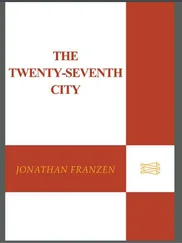Jonathan Franzen - The Discomfort Zone
Здесь есть возможность читать онлайн «Jonathan Franzen - The Discomfort Zone» — ознакомительный отрывок электронной книги совершенно бесплатно, а после прочтения отрывка купить полную версию. В некоторых случаях можно слушать аудио, скачать через торрент в формате fb2 и присутствует краткое содержание. Город: Ney York, Год выпуска: 2006, ISBN: 2006, Издательство: Farrar, Straus and Giroux, Жанр: Современная проза, на английском языке. Описание произведения, (предисловие) а так же отзывы посетителей доступны на портале библиотеки ЛибКат.
- Название:The Discomfort Zone
- Автор:
- Издательство:Farrar, Straus and Giroux
- Жанр:
- Год:2006
- Город:Ney York
- ISBN:918-0-312-94841-2
- Рейтинг книги:3.5 / 5. Голосов: 2
-
Избранное:Добавить в избранное
- Отзывы:
-
Ваша оценка:
- 80
- 1
- 2
- 3
- 4
- 5
The Discomfort Zone: краткое содержание, описание и аннотация
Предлагаем к чтению аннотацию, описание, краткое содержание или предисловие (зависит от того, что написал сам автор книги «The Discomfort Zone»). Если вы не нашли необходимую информацию о книге — напишите в комментариях, мы постараемся отыскать её.
Notable Book of the Year The Discomfort Zone
The Discomfort Zone — читать онлайн ознакомительный отрывок
Ниже представлен текст книги, разбитый по страницам. Система сохранения места последней прочитанной страницы, позволяет с удобством читать онлайн бесплатно книгу «The Discomfort Zone», без необходимости каждый раз заново искать на чём Вы остановились. Поставьте закладку, и сможете в любой момент перейти на страницу, на которой закончили чтение.
Интервал:
Закладка:
MY BIRD PROBLEM
FEBRUARY 2005, SOUTHTexas: I’d checked into a roadside motel in Brownsville and was getting up in the dark every morning, making coffee for my old friend Manley, who wouldn’t talk to me or leave his bed until he’d had some, and then bolting the motel’s free breakfast and running to our rental car and birding nonstop for twelve hours. I waited until nightfall to buy lunch food and fill the car with gas, to avoid wasting even a minute of birdable daylight. The only way not to question what I was doing, and why I was doing it, was to do absolutely nothing else.
At the Santa Ana National Wildlife Refuge, on a hot weekday afternoon, Manley and I hiked several miles down dusty trails to an artificial water feature on the far margin of which I saw three pale-brown ducks. Two of them were paddling with all deliberate speed into the cover of dense reeds, affording me a view mainly of their butts, but the third bird loitered long enough for me to train my binoculars on its head, which looked as if a person had dipped two fingers in black ink and drawn horizontal lines across its face.
“A masked duck!” I said. “You see it?”
“I see the duck,” Manley said.
“A masked duck!”
The bird quickly disappeared into the reeds and gave no sign of reemerging. I showed Manley its picture in my Sibley .
“I’m not familiar with this duck,” he said. “But the bird in this picture is the one I just saw.”
“The stripes on its face. The sort of cinnamony brown.”
“Yes.”
“It was a masked duck!”
We were within a few hundred yards of the Rio Grande. On the other side of the river, if you traveled south — say, to Brazil — you could see masked ducks by the dozens. They were a rarity north of the border, though. The pleasure of the sighting sweetened our long tramp back to the parking lot.
While Manley lay down in the car to take a nap, I poked around in a nearby marsh. Three middle-aged white guys with good equipment asked me if I’d seen anything interesting.
“Not much,” I said, “except a masked duck.”
All three began to talk at once.
“A masked duck!”
“Masked duck?”
“Where exactly? Show us on the map.”
“Are you sure it was a masked duck?”
“You’re familiar with the ruddy duck. You do know what a female ruddy looks like.”
“Masked duck!”
I said that, yes, I’d seen female ruddies, we had them in Central Park, and this wasn’t a ruddy duck. I said it was as if somebody had dipped two fingers in black ink and—
“Was it alone?”
“Were there others?”
“A masked duck!”
One of the men took out a pen, wrote down my name, and had me pinpoint the location on a map. The other two were already moving down the trail I’d come up.
“And you’re sure it was a masked duck,” the third man said.
“It wasn’t a ruddy,” I said.
A fourth man stepped out of some bushes right behind us. “I’ve got a nighthawk sleeping in a tree.”
“This guy saw a masked duck,” the third man said.
“A masked duck! Are you sure? Are you familiar with the female ruddy?”
The other two men came hurrying back up the trail. “Did someone say nighthawk?”
“Yeah, I’ve got a scope on it.”
The five of us went into the bushes. The nighthawk, asleep on a tree branch, looked like a partly balled gray hiking sock. The scope’s owner said that the friend of his who’d first spotted the bird had called it a lesser nighthawk, not a common. The well-equipped trio begged to differ.
“He said lesser? Did he hear its call?”
“No,” the man said. “But the range—”
“Range doesn’t help you.”
“Range argues for common, if anything, at this time of year.”
“Look where the wing bar is.”
“Common.”
“Definitely calling it a common.”
The four men set off at a forced-march pace to look for the masked duck, and I began to worry. My identification of the duck, which had felt ironclad in the moment, seemed dangerously hasty in the context of four serious birders marching several miles in the afternoon heat. I went and woke up Manley.
“The only thing that matters,” he said, “is that we saw it.”
“But the guy took my name down. Now, if they don’t see it, I’m going to get a bad rep.”
“If they don’t see it, they’ll think it’s in the reeds.”
“But what if they see ruddies instead? There could be ruddies and masked ducks, and the ruddies aren’t as shy.”
“It’s something to be anxious about,” Manley said, “if you want to be anxious about something.”
I went to the refuge visitor center and wrote in the log-book: One certain and two partially glimpsed masked ducks, north end of Cattail #2. I asked a volunteer if anyone else had reported a masked duck.
“No, that would be our first this winter,” she said.
The next afternoon, on South Padre Island, in the wetland behind the Convention Center, where about twenty upper-Midwestern retirees and scraggly-bearded white guys were pacing the boardwalks with cameras and binoculars, I saw a pretty, dark-haired young woman taking telephoto pictures of a pair of ducks. “Green-winged teals,” I mentioned to Manley.
The girl looked up sharply. “Green-winged teals? Where?”
I nodded at her birds.
“Those are wigeons,” she said.
“Right.”
I’d made this mistake before. I knew perfectly well what a wigeon looked like, but sometimes, in the giddiness of spotting something, my brain got confused. As Manley and I retreated down the boardwalk, I showed him pictures.
“See,” I said, “the wigeon and the green-winged teal have more or less the same palette, just completely rearranged. I should have said wigeon. Now she thinks I can’t tell a wigeon from a teal.”
“Why didn’t you just tell her that?” Manley said. “Just say that the wrong word came out of your mouth.”
“That would only have compounded it. It would have been protesting too much.”
“But at least she’d know you know the difference.”
“She doesn’t know my name. I’ll never see her again. That is my only conceivable consolation.”
There is no better American place for birds in February than South Texas. Although Manley had been down here thirty years earlier, as a teenage birder, it was a wholly new world to me. In three days, I’d seen fetchingly disheveled anis flopping around on top of shrubs, Jurassic-looking anhingas sun-drying their wings, squadrons of white pelicans gliding downriver on nine-foot wingspans, a couple of caracaras eating a road-killed king snake, an elegant trogon and a crimson-collared grosbeak and two exotic robins all lurking on a postage-stamp Audubon Society tract in Weslaco. The only frustration was my No. 1 trip target bird, the black-bellied whistling-duck. A tree nester, strangely long-legged, with a candy-pink bill and a bold white eye ring, the whistling-duck was one of those birds in the field guide which I couldn’t quite believe existed — something out of Marco Polo. It was supposed to winter in good numbers on Brownsville’s urban oxbow lakes (called resacas ), and with each shoreline that I scanned in vain, the bird became that much more mythical to me.
Out on South Padre, as fog rolled in off the Gulf of Mexico, I remembered to look up at the city water tower, where, according to my guidebook, a peregrine falcon often perched. Sure enough, very vaguely, I saw the peregrine up there. I set up my spotting scope, and an older couple, two seasoned-looking birders, asked me what I had.
“Peregrine falcon,” I said proudly.
“You know, Jon,” Manley said, his eye to the scope, “the head looks more like an osprey.”
Читать дальшеИнтервал:
Закладка:
Похожие книги на «The Discomfort Zone»
Представляем Вашему вниманию похожие книги на «The Discomfort Zone» списком для выбора. Мы отобрали схожую по названию и смыслу литературу в надежде предоставить читателям больше вариантов отыскать новые, интересные, ещё непрочитанные произведения.
Обсуждение, отзывы о книге «The Discomfort Zone» и просто собственные мнения читателей. Оставьте ваши комментарии, напишите, что Вы думаете о произведении, его смысле или главных героях. Укажите что конкретно понравилось, а что нет, и почему Вы так считаете.












